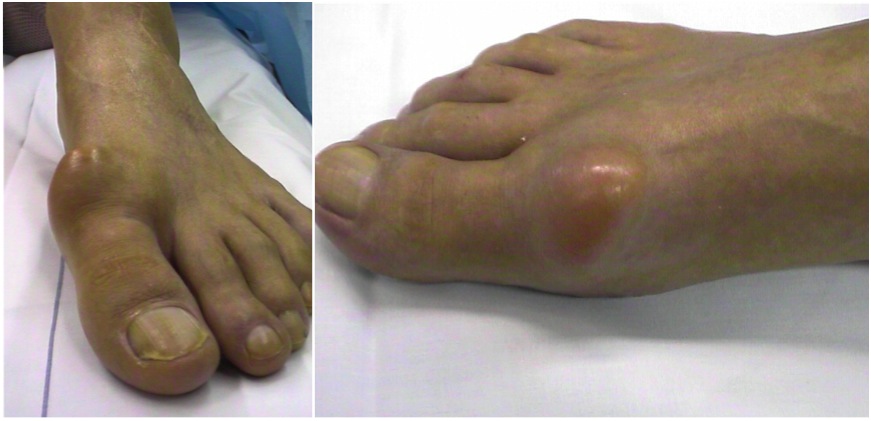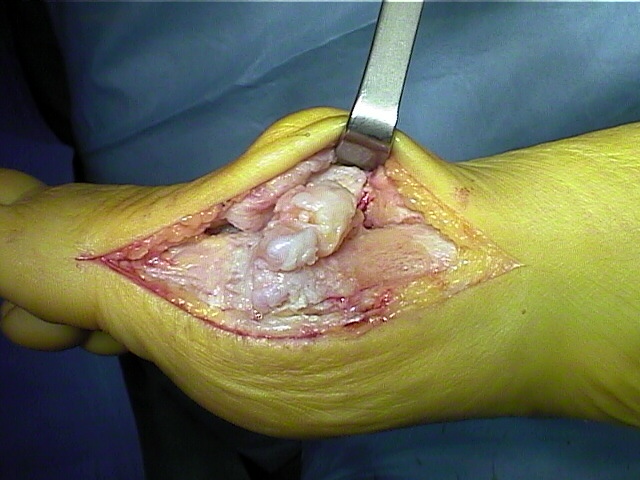Hallux rigidus
Definition
The term “hallux” means “big toe”. When the big toe shows a loss of mobility in the upward and downward movement, it will produce a kind of stiffness at the level of the first metatarsal joint, which is called “rigidus”.
Causes
In the absence of symptoms and distortion, this joint normally shows an upward arc of about 75 degrees and a downside of about 25 degrees. The lateral movement is virtually nonexistent. Typically in the case of hallux rigidus, there is a loss of mainly the upward movement in a straight toe, without deviation to or away from the other toes, in which a certain degree of osteoarthritis is present. Real cause identification is often difficult, yet a prior trauma of the big toe is the most frequent cause.
Symptoms


The pain is mainly present during the push-off phase, while walking and running, when the big toe blocks in dorsiflexion. At clinical examination, the reduced mobility, the presence of bone spurs (osteophytes) at the top and on both sides of the joint, an irritation of one or more nerves that are pulled by a downward movement,… are diagnosed. Most patients complain of ”start stiffness” and also of a mechanical pain, which gets worse as activities increase during the day.
The diagnosis is largely clinical. An X-ray is useful to confirm the diagnosis, but also to plan a possible surgical intervention.
Treatment
First, a conservative, non-operative treatment should be tried, because a certain percentage of patients benefits from it, to the extent that an operation may be unnecessary. To alleviate pain in the joint, one must try to let the joint rest. This can be achieved by stiffening the sole of the shoe, through which the joint no longer folds while walking. Moreover, when the sole forms a kind of curve, it facilitates the push-off phase significantly. Thin, flexible soles and high heels aggravate the pain because there is more pressure on the joints. Analgesia, anti-inflammatory drugs and, if necessary, an infiltration into the joint can also bring solace.
In case of persistent pain, several interventions are possible, depending on the degree of osteoarthritis, the length of the metatarsal bone, the present motion, a metatarsus elevatus, age, and activities… Several procedures can be combined, but the key element is the excision of the bone outgrowth.
- A cheilectomy is the term used for the debridement of the joint, provided that the osteophytes are removed, and in most cases there will be a removal of about 1/3 of the back of the head of the metatarsal as well. This is the minimum operation, and does not preclude other interventions in the future. In most cases, it is sufficient, if there is not too much narrowing of the joint space yet, and osteoarthritis is not too far advanced.
- An osteotomy at the level of the phalanx or the metatarsal, aims at reducing the pressure on the joint on the one hand, and at winning upward mobility on the other hand.
- If the osteoarthritis increases, previous interventions have less chance of success. For these patients, either arthrodesis or metatarsophalangeal prosthesis is proposed. The big difference is the sacrifice versus preservation of joint mobility. The advantages of an arthrodesis are the fact that it concerns a final correction, and that the guarantee on the elimination of pain and osteoarthritis is very high. Basically, you, as a patient, experience no restrictions on your daily functioning, sports, etc. However, the loss of motion makes it almost impossible to wear heels higher than 2 to 3 cm. However, this is possible with the placement of a prosthesis, but not everyone is eligible for such surgery. Much depends on osteoarthritis at the height of the sesamoid bones. Furthermore, the life span of a prosthesis is limited to about 10 years, and then again, surgery should be undertaken. The only option then is arthrodesis, which would be technically more difficult to achieve at that time.
Postoperative policy
For more information on the care, the disability, etc., please read the information leaflet concerning the pathology of the forefoot.

